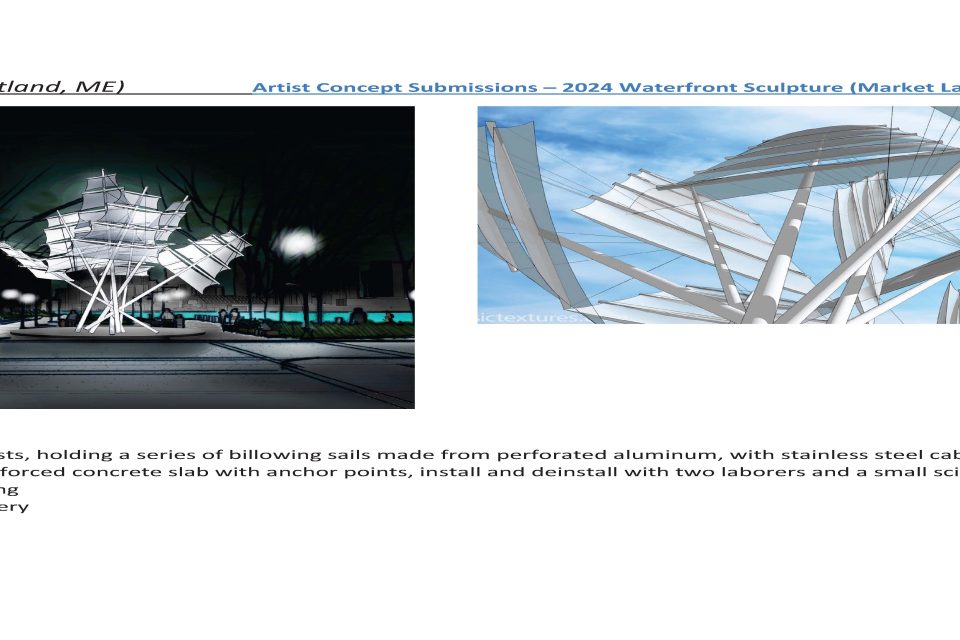NEWBURYPORT WATERFRONT – Aaron T Stephan has a studio two blocks from the working Portland, ME, docks and has long been interested in the men and women who labor there building ships.
Last week, Stephan attributed his walks around the docks to his inspiration to create a tall clipper ship sculpture for the new Market Landing Park on the Merrimack Waterfront. Stephan was awarded the commission by the newly formed Public Art Commission, beating out 20 other artists.
Born in Springville, NY, Stephan works in sculpture and mixed media. He often uses humor and wit to look at everyday objects “not as metaphors,…but [as] facts,” stated his web site, aarontstephan.com.
He said his sculpture of the sails of a clipper ship will take eight months and be erected in one of the park’s most prominent spots off the new bike trail that links the two sections of the rail trail.
“I am really excited about this project,” he said.
The committee, which made the decision after interviewing the five finalists last week, is made up of Peter Carzasty, Paula Estey, Katherine Moran, Shanna Sartori, Cynthia Schartman, Kim Turner and Nichole Whelan. City Planning Director Andy Port, who oversees the entire park development, is coordinating the project.
Given that the Newburyport High School mascot is the clippers, having the signature sculpture depicting a clipper ship would seem to be appropriate. Some committee members wanted Stephan to include some reference to the role clipper ships played in the slave trade.
Stephan agreed, but noted that clipper ships played a minimal role in the slave trade. The sleek, fast ships were developed in the mid-1800s, decades after the U.S. prohibited Africans being brought as slaves in 1808.
Clipper ships were lightweight with narrow hulls and limited cargo space. They were built to carry time sensitive, high value cargo such as tea from China. The large crews required to manage the clipper ships’ massive sails reduced the number of passengers they carried.
Slave ships were typically slow, bulky freighters, designed to maximize the amount of human cargo.
Some clipper ships, particularly the Baltimore clippers, smuggled slaves after the 1808 embargo, but that was not their primary function.
The size of Stephan’s sculpture will likely be 12 to 15 feet tall, which will stand out on the flat park space. The city hopes that it will attract visitors and residents to the waterfront.
Entitled “Sail Trace,” the sculpture will have eight life-sized masts, holding a series of billowing sails made from perforated aluminum, with stainless steel cables as rigging. It will have in-ground uplighting.
The sculpture will be sited on a paved space between the new bike trail through the park and the waterfront boardwalk. The space will have bike racks to the east and benches to the west of the sculpture.
The process of selecting the sculptor was rushed because the city has until the end of June to award the commission when the grant of $75,000 must be awarded. And that is the total budget, including installation.
In response to its Call to Artists, the committee received 21 submissions by artists/sculptors that range from local artists, a few who already have pieces erected in the city and others who work in studios as far away as southern California, Key West and the Dakota tribal lands in Minnesota.
The finalists were James Dinh of Cerritos, CA; Mark Faverman from Boston; Scott Goss from Shaker Heights, OH; Erin Genia, a member of the Sisseton-Wahpeton Dakota native American tribe, and Stephan.
Sculptor Chosen for Signature Waterfront Art
Tuesday May 28, 2024

Aaron T Stephan - Waterfront Art



